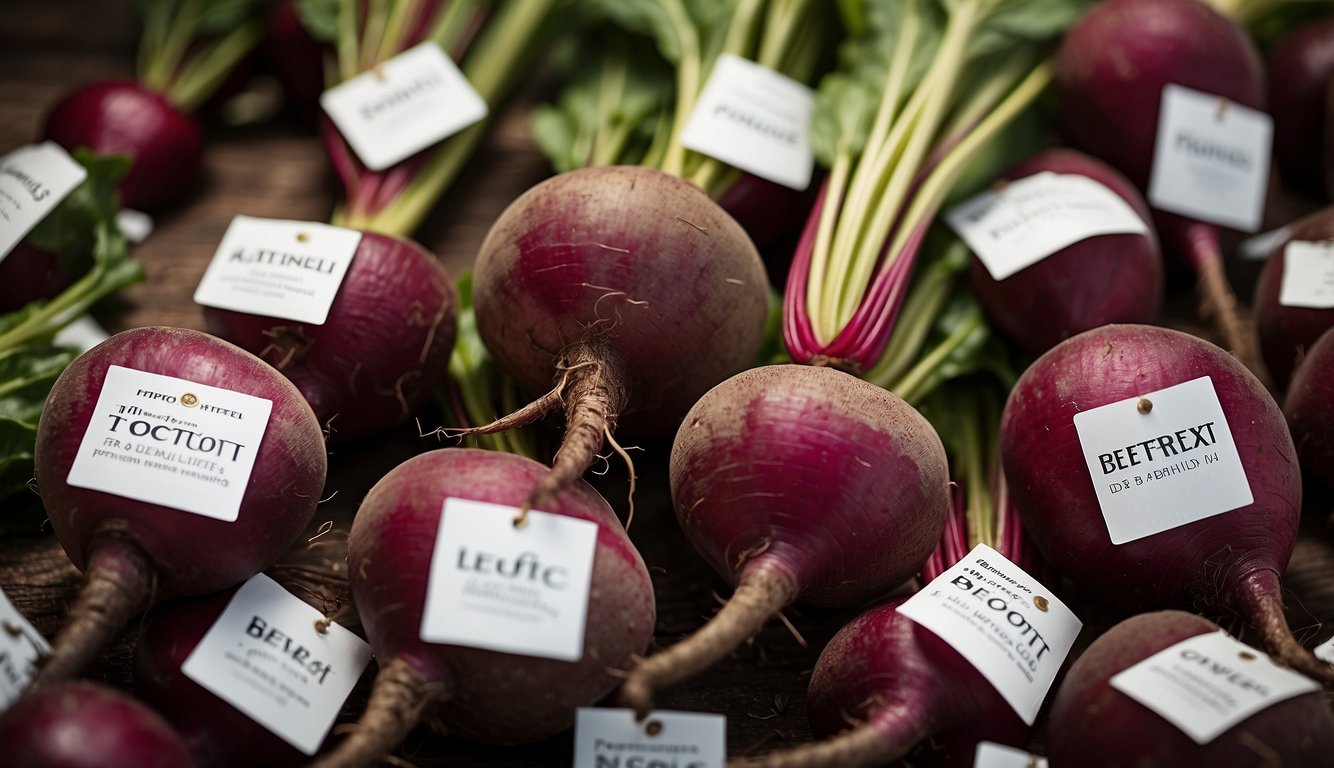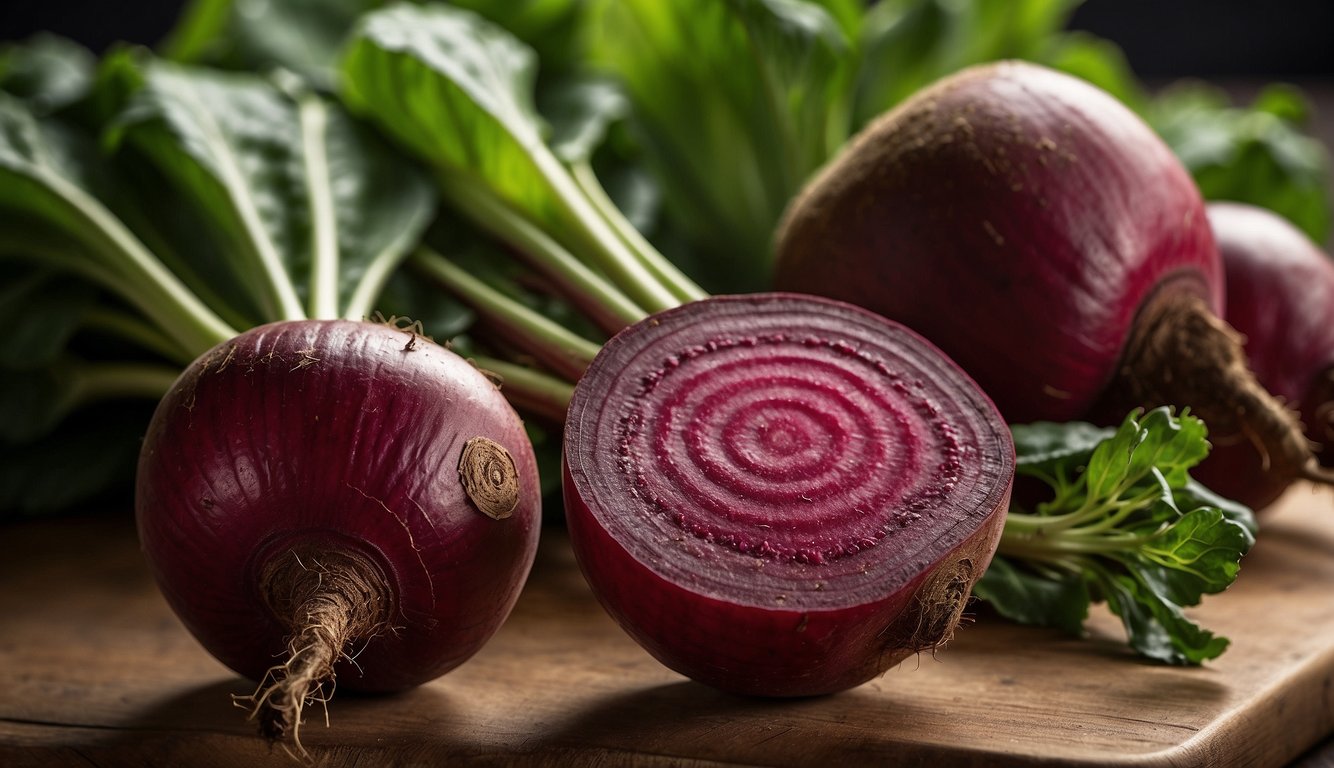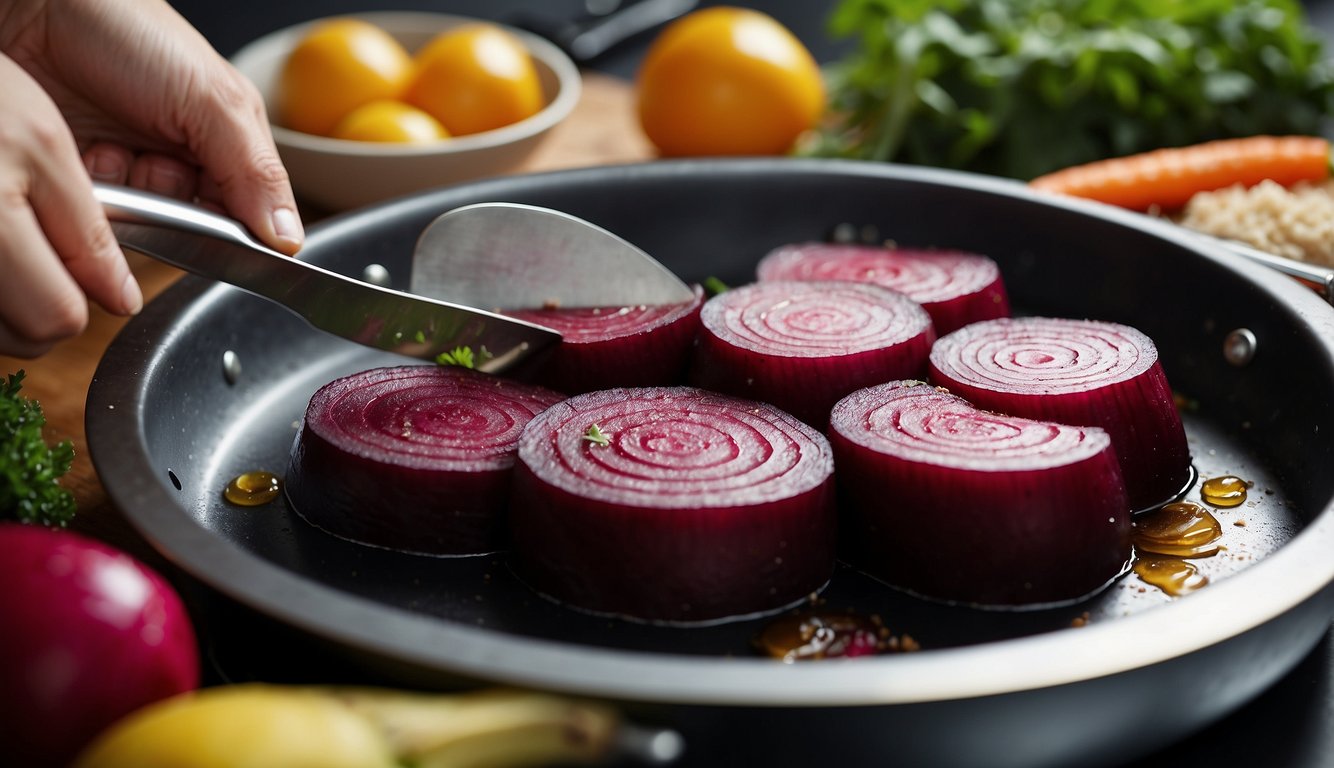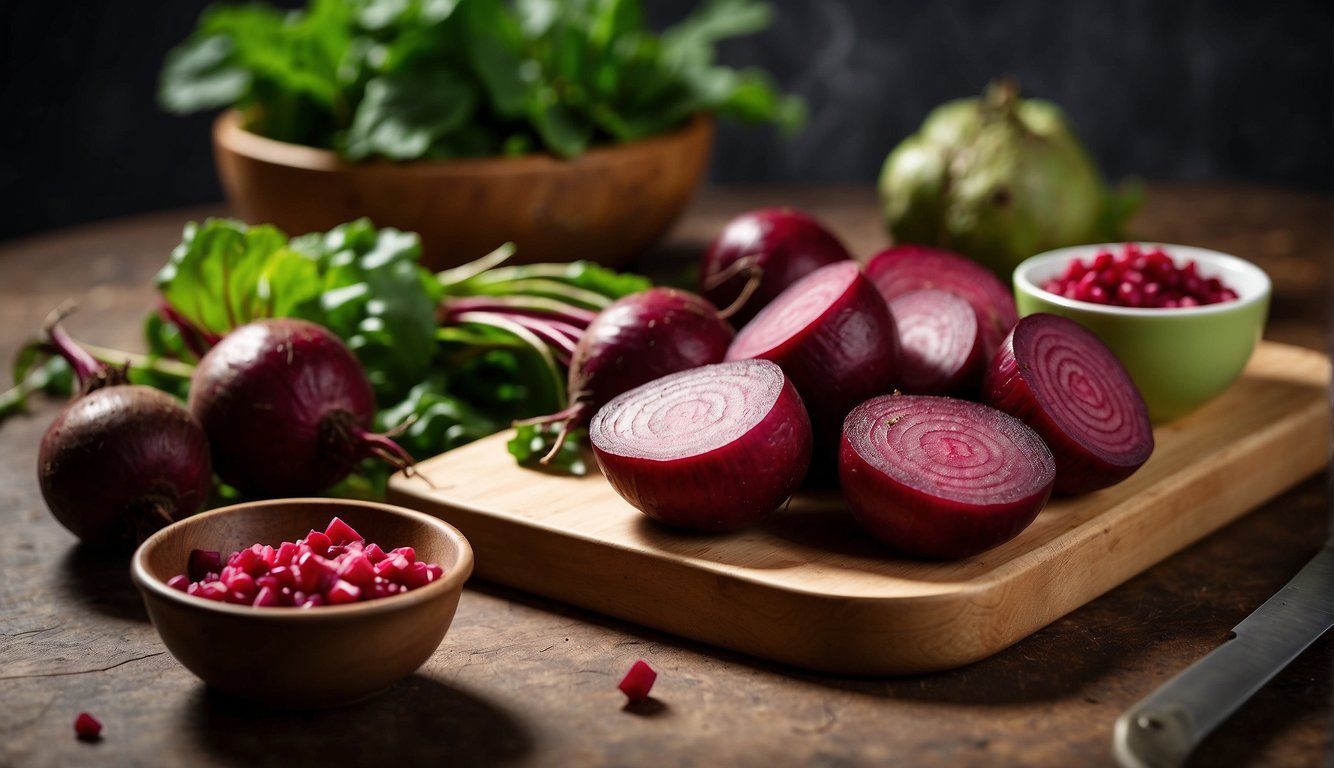TheHerbProf.com is a treasure trove of knowledge for those interested in natural healing and herbal remedies. The website is run by Paul Johnston MD. A naturopathic who has not only received extensive education in the field but also has personal experience in self-healing.
Beetroot and beets are two terms that are often used interchangeably, but are they really the same thing? As someone who has been interested in cooking and gardening for years, I can say that there is a difference between beetroot and beets, although the distinction may not be immediately obvious.
Beetroot refers specifically to the root of the beet plant, which is typically cooked or pickled and used in recipes. Beets, on the other hand, refer to the entire plant, including the root and the greens. While the two terms are related, they are not interchangeable, and using them as such can lead to confusion in recipes. In this article, I will delve deeper into the differences between beetroot and beets, and explain why it’s important to use the correct term when cooking or gardening.
Beetroot and Beets: Understanding the Terminology

Definitions and Origins
As a plant species, Beta vulgaris is commonly referred to as beet, and it has several varieties. The most popular varieties are table beet, garden beet, red beet, and golden beet. Beetroot is the taproot of the beet plant, which is typically cooked or pickled and used in recipes. It is also known as the dinner beet, and it is commonly found in Europe and the UK.
Beetroot has been cultivated for centuries, and it is believed to have originated in North Africa. The ancient Greeks and Romans used beetroot for medicinal purposes, and it was not until the 16th century that it was used as a food source. In North America, beetroot is commonly referred to as beets.
Common Names and Varieties
The terms beet and beetroot generally refer to the same species of vegetable, Beta vulgaris. However, there are some differences between the two terms. Beet is a more general term that refers to the entire plant, including the root and the greens. On the other hand, beetroot refers specifically to the root of the beet plant.
There are several varieties of beets, including red beets, golden beets, and white beets. Red beets are the most commonly found variety and are known for their deep red color. Golden beets are a lighter color and have a milder taste than red beets. White beets are the least common variety and are known for their sweet taste.
Sugar beet is another variety of beet that is grown specifically for its high sugar content. It is commonly used in the production of sugar. Sea beet is a wild variety of beet that is found growing along the coastlines of Europe.
While there are some differences in terminology, beet and beetroot generally refer to the same species of vegetable, Beta vulgaris. The terms can be used interchangeably in most cases, but it is important to note that beet refers to the entire plant, while beetroot specifically refers to the root of the plant.
Botanical Characteristics of Beetroot

Plant Structure
Beetroot, also known as table beet, garden beet, or red beet, is a taproot vegetable that is scientifically known as Beta vulgaris. The plant has a thick, fleshy, and round taproot that grows underground and is the edible part of the plant. The taproot is attached to a stem that has green leaves growing out of it. The leaves are broad and have a reddish-purple color, and they are also edible.
The entire plant can grow up to 2-3 feet tall, and the taproot can reach a diameter of up to 3-4 inches. The taproot is the most commonly consumed part of the plant and can be eaten raw or cooked. The leaves are also edible and can be cooked like spinach or used in salads.
Color Variations
Beetroot is commonly known for its vibrant red color, but it can also come in other colors such as purple, yellow, and golden. The red color of the beetroot is due to the presence of a pigment called betacyanin. The purple and golden colors are also due to the presence of pigments, but they are different from the ones found in red beetroot.
The color of the beetroot can also vary depending on the soil it is grown in and the climate. The red color is more common in cooler climates, while the golden and yellow colors are more common in warmer climates. The color of the beetroot can also be affected by the age of the plant, with younger plants having a more vibrant color.
Beetroot is a taproot vegetable with a thick, fleshy, and round edible root attached to a stem with green leaves growing out of it. The plant can grow up to 2-3 feet tall, and the taproot can reach a diameter of up to 3-4 inches. Beetroot is commonly known for its vibrant red color, but it can also come in other colors such as purple, yellow, and golden.
Nutritional Profile of Beetroot – Is Beetroot the Same as Beets?

Macronutrients and Micronutrients
Beetroot is a root vegetable that is low in calories and high in nutrients. It is an excellent source of fiber, which helps to regulate digestion and maintain bowel health. It is also a good source of iron, folate, manganese, and vitamin C, which are essential for healthy blood and immune function.
According to Healthline, raw or cooked beetroot offers about 8-10% carbs. Simple sugars such as glucose and fructose make up 70-80% of these carbohydrates, respectively. Beetroots are also high in fructans, short-chain carbohydrates that can be difficult for some people to digest.
Health Benefits – Is Beetroot the Same as Beets?
Beetroot is a nutrient-dense food that offers several potential health benefits. It is high in nitrates, which the body converts into nitric oxide, a molecule that helps to relax and widen blood vessels. This can lead to improved blood flow and lower blood pressure levels, particularly systolic blood pressure.
In addition, beetroot is rich in antioxidants and plant compounds, which can help to protect the body against oxidative stress and inflammation. These compounds may also have anti-cancer properties and help to support liver function.
According to Medical News Today, beetroot may also benefit people with diabetes by helping to lower glucose levels and increase insulin sensitivity. It may also improve exercise performance and endurance by reducing the amount of oxygen needed during physical activity.
Overall, beetroot is a highly nutritious food that offers several potential health benefits. Incorporating it into your diet can help to support overall health and well-being.
Culinary Uses of Beetroot – Is Beetroot the Same as Beets?

Beetroot is a versatile vegetable that can be used in a variety of dishes. It has an earthy flavor that is both sweet and slightly bitter, making it a unique ingredient to work with. Here are some popular culinary uses of beetroot:
Popular Beetroot Dishes – Is Beetroot the Same as Beets?
One of the most popular dishes that use beetroot is borscht, a soup that originated in Eastern Europe. Borscht is made with beets, onions, carrots, and other vegetables, and is often served with sour cream. It is a hearty and flavorful dish that is perfect for cold winter days.
Beetroot can also be used to make hummus, a dip that is commonly served with pita bread. The addition of beetroot gives the hummus a vibrant pink color and a slightly sweet taste. It is a healthy and delicious snack that is perfect for parties or as an appetizer.
Cooking Techniques
Beetroot can be cooked in a variety of ways, including roasting, boiling, and pickling. Roasting is a popular technique that brings out the natural sweetness of the vegetable. To roast beets, simply wash and peel them, then cut them into wedges. Toss the wedges with olive oil, salt, and pepper, and roast them in the oven until they are tender and caramelized.
Pickling is another popular technique that is often used to preserve beets. To pickle beets, simply boil them until they are tender, then peel and slice them. Combine vinegar, sugar, and spices in a saucepan, and bring the mixture to a boil. Pour the mixture over the beets, and let them sit in the refrigerator for a few days to absorb the flavors.
Beetroot can also be used to make juice, which is a popular health drink. Beetroot juice is rich in antioxidants and is believed to have many health benefits, including lowering blood pressure and improving athletic performance. It can be consumed on its own or mixed with other fruits and vegetables to create a delicious and nutritious beverage.
Beetroot is a versatile vegetable that can be used in a variety of dishes. Its earthy flavor and sweet taste make it a unique ingredient that can be used to create both savory and sweet dishes. Whether you are roasting, boiling, pickling, or juicing it, beetroot is a healthy and delicious addition to any meal.
Beetroot in Lifestyle and Medicine – Is Beetroot the Same as Beets?

As a nutritionist, I often get asked if beetroot and beets are the same thing. The answer is yes, they are the same vegetable. Beetroot, also known as red beet, garden beet, or simply beet, refers to the root portion of the Beta vulgaris plant. The term “beets” is commonly used in North America to describe the same vegetable.
Beetroot is a nutrient-dense vegetable that has been found to have various health benefits. In this section, I will explore how beetroot can be beneficial for athletic performance and medical research.
Athletic Performance – Is Beetroot the Same as Beets?
Beetroot is known to improve athletic performance due to its high nitrate content. Nitrates are converted to nitric oxide in the body, which helps to dilate blood vessels and increase blood flow to the muscles. This increased blood flow can improve endurance and reduce fatigue during exercise.
A study published in the Journal of the Academy of Nutrition and Dietetics found that consuming beetroot juice can enhance running performance in healthy adults. The study showed that the participants who drank beetroot juice before exercise were able to run faster and longer than those who did not.
Medical Research
Beetroot has also been found to have various health benefits in medical research. Beetroot contains betalains, which are pigments that have antioxidant and anti-inflammatory properties. These properties can help to protect against heart disease, cancer, and stroke.
A study published in the American Journal of Clinical Nutrition found that consuming beetroot juice can lower blood pressure in individuals with hypertension. The study showed that the participants who drank beetroot juice had a significant reduction in blood pressure compared to those who did not.
Beetroot is a nutrient-dense vegetable that can be beneficial for athletic performance and medical research. Its high nitrate and betalain content can help to improve endurance, reduce inflammation, and protect against various diseases. Incorporating beetroot into your diet can be a simple and delicious way to boost your health.
Agricultural Aspects of Beetroot – Is Beetroot the Same as Beets?

Cultivation and Harvesting – Is Beetroot the Same as Beets?
As a root vegetable, beetroot is grown for its round, earthy, and nutritious roots. It requires well-drained soil and regular watering, and can be grown in both warm and cool climates. The plant can grow up to 2 feet tall and has dark green leaves that are similar to chard or spinach.
Beetroot is typically harvested in the fall, after the roots have reached a diameter of 1-3 inches. The roots are dug up and washed, and then can be stored for several months in a cool, dry place.
Commercial Production
Beetroot is widely cultivated around the world, with Eastern Europe being one of the largest producers. In addition to being consumed fresh or cooked, beetroot is also used in sugar production. Varieties of beets used for sugar production have a higher sugar content in their roots than those used for consumption.
Commercial production of beetroot requires large-scale farming and harvesting equipment. The roots are typically mechanically harvested, washed, and then sent to processing facilities for further cleaning and packaging.
Overall, beetroot is a versatile and nutritious crop that is consumed in many forms, from pickled beets to beet juice. It has a long history of cultivation and is an important crop for both small-scale and commercial farmers. Garlic can also be planted alongside beetroot to help repel pests and improve soil quality.
Health Considerations and Risks – Is Beetroot the Same as Beets?

Dietary Cautions
Beetroot and beets are generally considered safe for consumption. However, if you have a history of kidney stones, you may want to exercise caution when consuming beetroot. This is because beetroot contains oxalates, which can contribute to the formation of kidney stones in some people.
Additionally, if you are on a low-carbohydrate or low-fat diet, you may want to limit your intake of beetroot. While beetroot is a nutritious food that is high in fiber and low in fat, it is also relatively high in carbohydrates.
Potential Side Effects – Is Beetroot the Same as Beets?
While beetroot is generally safe for consumption, there are a few potential side effects to be aware of. One of the most common side effects of consuming beetroot is that it can cause your urine and stool to turn red. This is due to the presence of betalains, which are pigments that give beetroot its distinctive color.
In some cases, consuming raw beets or beetroot soup can cause digestive upset, including bloating, gas, and diarrhea. If you experience these symptoms after consuming beetroot, you may want to try cooking the beets thoroughly before eating them.
Finally, if you have high blood pressure, you may want to exercise caution when consuming beetroot. While beetroot has been shown to have blood pressure-lowering effects due to its ability to dilate blood vessels, it is also relatively high in salt. If you are trying to limit your salt intake, you may want to consume beetroot in moderation.
Overall, while beetroot and beets are generally safe for consumption, it is important to be aware of these potential risks and to consume them in moderation as part of a balanced diet.
Is Beetroot the Same as Beets?
Let’s dig into the question: Is beetroot the same as beets?
Well, the answer is yes and no. Beetroot is the root part of the beet plant, known for its deep red color and sweet, earthy flavor. It’s packed with nutrients and is a favorite in many cuisines around the world.
On the other hand, beets refer to the entire plant, including the leafy green tops. These greens are just as nutritious as the roots and can be cooked or eaten raw in salads.
Now, how do they help each other? Well, they’re the same plant! The roots nourish the leaves, and the leaves, through photosynthesis, provide energy for the roots. It’s a beautiful cycle of mutual support!
Remember, folks, every part of the plant has its purpose. So, let’s keep exploring, keep learning, and keep appreciating the wonders of nature!
For more botanical wisdom, don’t forget to visit my homepage at theherbprof.com. Keep those green thumbs up!
References – Is Beetroot the Same as Beets?
Little Herb Encyclopedia, by Jack Ritchason; N.D., Woodland Publishing Incorporated, 1995
The Ultimate Healing System, Course Manual, Copyright 1985, Don Lepore
Planetary Herbology, Michael Tierra, C.A., N.D., Lotus Press, 1988
Handbook of Medicinal Herbs, by James A. Duke, Pub. CRP Second Edition 2007
The Complete Medicinal Herbal, by Penelope Ody, Published by Dorling Kindersley
Check the Following Articles!
Rare Vegetables List: 10 Unique & Nutritious Options to Try
Red Sweet Pepper: Health Benefits and Delicious Recipes
Types of Kale Leaves: A Guide to Varieties and Uses
Frequently Asked Questions – Is Beetroot the Same as Beets?

What are the differences between sugar beet and beetroot?
Sugar beet is a variety of beet that is mainly grown for its high sugar content. It is usually white and has a much higher sugar content than beetroot. On the other hand, beetroot is a root vegetable that is commonly consumed for its nutritional benefits. It is usually red or purple in color and has a sweet, earthy taste.
What are the health benefits of beetroot for women?
Beetroot is a good source of folate, which is important for women of childbearing age. Folate helps to prevent birth defects and is also important for the production of red blood cells. Additionally, beetroot is high in iron, which is important for women who are menstruating or pregnant.
Can consuming beetroot have any adverse effects on certain individuals?
Consuming beetroot can cause some individuals to experience a temporary discoloration of their urine and/or stool. This is a harmless side effect and is caused by the pigments in the beetroot. However, individuals with kidney problems should be cautious when consuming beetroot due to its high oxalate content.
What are the advantages of eating beetroot compared to taking beet supplements?
While beet supplements may contain similar nutrients as beetroot, they lack the dietary fiber that is found in whole foods. Additionally, consuming whole foods like beetroot may have additional health benefits beyond just the nutrients they contain. For example, the nitrates in beetroot may help to lower blood pressure.
How does beetroot consumption impact men’s health?
Beetroot consumption may have a positive impact on men’s health due to its high nitrate content. Nitrate is converted to nitric oxide in the body, which can help to improve blood flow and lower blood pressure. Additionally, beetroot is high in antioxidants, which can help to protect against oxidative stress and inflammation.
What is the scientific name for beetroot?
The scientific name for beetroot is Beta vulgaris. It is a member of the Amaranthaceae family and is closely related to other root vegetables like turnips and carrots.


